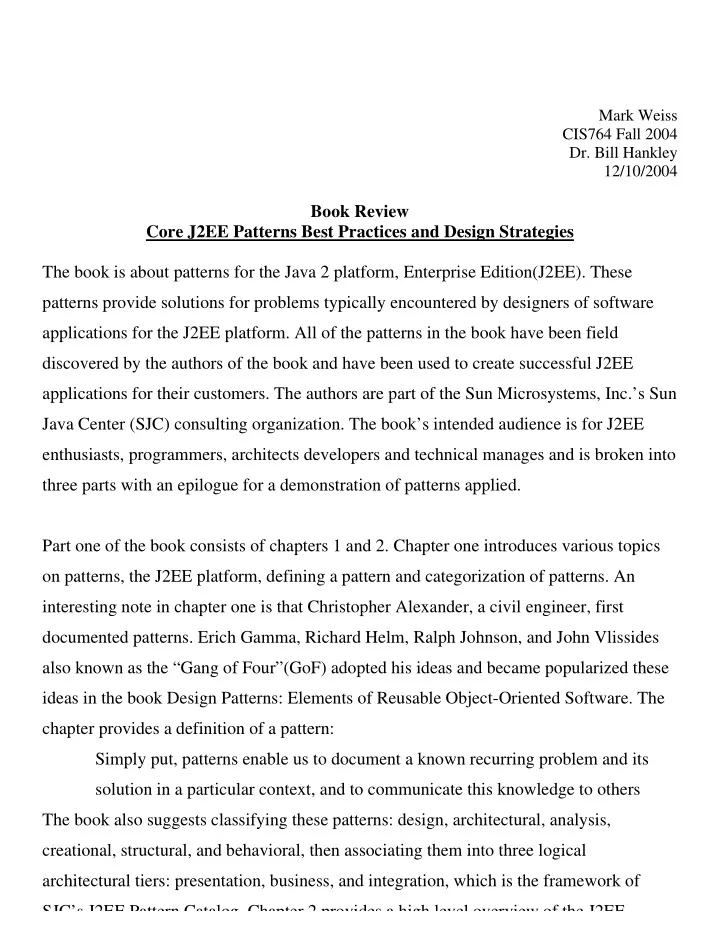

Mark Weiss CIS764 Fall 2004 Dr. Bill Hankley 12/10/2004 Book Review Core J2EE Patterns Best Practices and Design Strategies The book is about patterns for the Java 2 platform, Enterprise Edition(J2EE). These patterns provide solutions for problems typically encountered by designers of software applications for the J2EE platform. All of the patterns in the book have been field discovered by the authors of the book and have been used to create successful J2EE applications for their customers. The authors are part of the Sun Microsystems, Inc.’s Sun Java Center (SJC) consulting organization. The book’s intended audience is for J2EE enthusiasts, programmers, architects developers and technical manages and is broken into three parts with an epilogue for a demonstration of patterns applied. Part one of the book consists of chapters 1 and 2. Chapter one introduces various topics on patterns, the J2EE platform, defining a pattern and categorization of patterns. An interesting note in chapter one is that Christopher Alexander, a civil engineer, first documented patterns. Erich Gamma, Richard Helm, Ralph Johnson, and John Vlissides also known as the “Gang of Four”(GoF) adopted his ideas and became popularized these ideas in the book Design Patterns: Elements of Reusable Object-Oriented Software. The chapter provides a definition of a pattern: Simply put, patterns enable us to document a known recurring problem and its solution in a particular context, and to communicate this knowledge to others The book also suggests classifying these patterns: design, architectural, analysis, creational, structural, and behavioral, then associating them into three logical architectural tiers: presentation, business, and integration, which is the framework of SJC’s J2EE Pattern Catalog. Chapter 2 provides a high level overview of the J2EE
integration tier respectively. The chapters discuss the design considerations and bad practices affiliated with these tiers. The design considerations are issues that a developer needs to consider while designing applications for the J2EE Platform. Chapter 5 includes some of the “refactorings” they have experienced in their experience that has enabled them to move a design from a less optimal solution to a better solution. The refactorings provide another way to think about the material in the rest of the book, providing what they believe to be valuable material to the pattern catalog. Part three of the book: J2EE Pattern Catalog presents SJC’s pattern catalog. The catalog contains the fifteen patterns that form the core of the book in chapters 6-9. Chapter 6 is the patterns overview. The chapter begins with a high level discussion of the pattern ideas and explains the way the patterns are categorized into tiers. It also explains the J2EE pattern template, which is used to present all patterns in the book. The chapter provides a nice diagram of all the patterns and their inter-relationships. It also provides a roadmap to the pattern catalog. The roadmap presents common design and architecture-related questions with references to patterns or refactorings that provide solutions to those questions. The roadmap table has two columns. “If you are looking for this” which is the question or problem and “Find it Here” which is the solution that contains the pattern name and the page number to find it. Chapters 7-9 present the patterns in their respective tiers. Each pattern follows a format in the book. The pattern template consists of the following sections: • Context: Sets the environment under which the pattern exists. • Problem: Describes the design issues faced by the developer. • Forces: Lists the reasons and motivations that affect the problem and the solution. The list of forces highlights the reasons why one might choose to use the pattern and provides a justification for using the pattern.
• Solution: Describes the solution approach briefly and the solution elements in detail. The solution section contains two sub-sections • Structure: Uses UML class diagrams to show the basic structure of the solution. The UML sequence diagrams in this section present the dynamic mechanisms of the solution. • Strategies: Describes different ways a pattern may be implemented. • Consequences: Pattern trade-offs are described. Generally, this section focuses on the results of using a particular pattern or its strategy, and notes the pros and cons that may result from the application of the pattern. • Related Patterns: This section lists other relevant patterns in the J2EE Pattern Catalog or from other external resources, such as the GoF design patterns. The final section of the book the epilogue discusses and demonstrates how patterns are combined and work together. This chapter reinforces the idea that patterns exist in a community, and that each pattern supports, and is supported by other patterns. This book is a staple for anyone developing applications for the J2EE platform. The book is easy to read with lots of examples. The use of UML in the book clearly illustrates the all of the examples as well as the core patterns. Maybe an improvement would be a little less refer it forward. For example, on page 39 there is a reference for more detail to go to page 73. Overall it was easy read and promotes a key element of reuse in software design.
References: Deepak Alur, John Crupi, Dan Malks. Core J2EE Patterns Best Practices and Design Strategies. New Jersey: Prentice Hall 2001 459pp. Core J2EE Patterns. Available from http://java.sun.com/blueprints/patterns/ Accessed October 27, 2004. Core J2EE Patterns. Available from http://www.corej2eepatterns.com/index.htm Accessed October 28, 2004
Recommend
More recommend